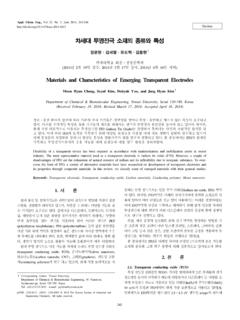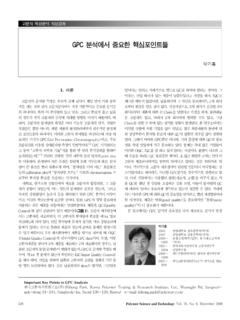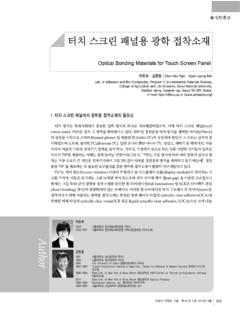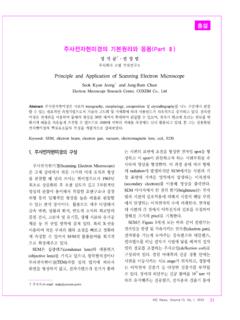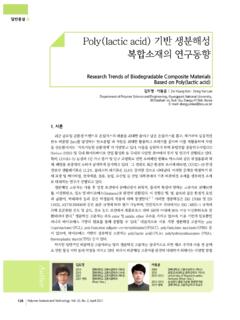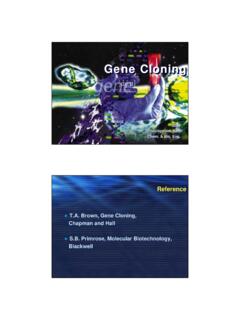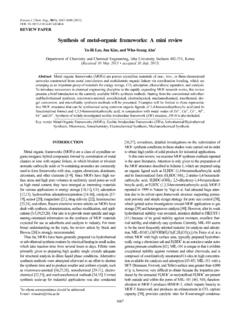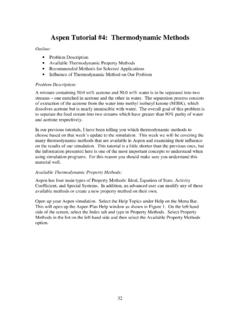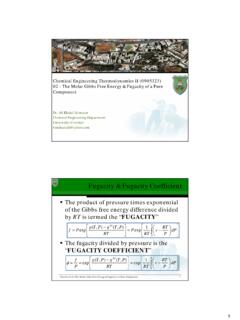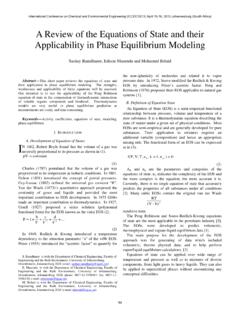Transcription of Modified Soave-Redlich-Kwong Equations of State Applied …
1 Korean J. Chem. Eng., 20(4), 709-715 (2003)709 To whom correspondence should be : Soave-Redlich-Kwong Equations of State Appliedto Mixtures Containing Supercritical Carbon DioxideJos O. Valderrama*,**, and Alexis Silva**Faculty of Eng., Mech. Eng. Dept., Univ. of La Serena, Casilla 554, La Serena-Chile**Centro de Informaci n Tecnol gica, Casilla 724, La Serena Chile(Received 8 February 2002 accepted 3 February 2003)Abstract The well-known equation of State Soave-Redlich-Kwong and two of its modifications are Applied todescribe vapor-liquid equilibrium in binary asymmetric mixtures, which contain supercritical carbon dioxide and aheavy component.
2 Several mixing rules including the classical van der Waals mixing rules with one and two interactionparameters, non-quadratic mixing rules, and the used of a Gibbs free energy model, are used with these mixtures containing supercritical carbon dioxide are considered in the study. The experimental data wereobtained from literature sources and the adjustable parameters were found by minimizing the errors between predictedand experimental data of the concentration of the solute in the liquid phase. The work allows concluding on theadvantages, disadvantages and expected accuracy of these Equations of State and mixing rules for correlating vapor-liquid equilibrium data in asymmetric systems as those words: Equations of State , SRK Equation, Supercritical Fluids, Vapor-liquid EquilibriumINTRODUCTIONThe most common method used for the correlation and predic-tion of phase equilibria in mixtures involves the use of Equations ofstate (EoS).
3 Common and industrially important EoS are the cubicequations derived from the van der Waals equation of State (VdW).Among the many cubic EoS of VdW type nowadays available, thoseof Redlich and kwong [1949], of soave [1972], of Peng and Ro-binson [1976], of Patel and Teja [1981], and the generalized PTVequation proposed by one of the authors [Valderrama, 1990], amongothers, have proven to combine the simplicity and accuracy requiredfor the prediction and correlation of volumetric and thermodynamicproperties of fluids [Wilson, 1966; Mihajlov et al.]
4 , 1981; Trebbleand Bishnoi, 1986; Valderrama and Rojas, 1999].The Soave-Redlich-Kwong EoS (SRK) is probably the most wide-ly employed model to correlate and predict fluid properties and phaseequilibria in the process industry. The SRK equation can be writtenin a general form as follows:(1)The parameters a and b for pure substances are determined by usingthe critical properties and the acentric factor. For mixtures, the pa-rameters a and b are also concentration dependent (am and bm), de-pendency expressed through defined mixing rules, as described 1970 to 1980, most of the applications of EoS to mixturesused the classical van der Waals mixing rules (VdW).
5 An interac-tion parameter has been introduced into the force parameter a toimprove predictions of mixture properties [Zudkevitch and Joffe,1970]. It has been recognized, however, that even with the use ofan interaction parameter the classical VdW mixing rules give accu-rate results for simple fluid mixtures only [Adachi and Sugie, 1985;Trebble, 1988; Shibata and Sandler, 1989].During the last twenty-five years, efforts have been made to ex-tend the applicability of cubic Equations of State to obtain accuraterepresentation of phase equilibria in many industrially important mix-tures.
6 The different approaches presented in the literature includethe use of multiple interaction parameters in the mixing rules [Kwakand Mansoori, 1986; Trebble and Bishnoi, 1988], the introductionof the local-composition concept [Heyen, 1983], the connection be-tween excess Gibbs free energy models and Equations of State [Huronand Vidal, 1979], and the use of non-quadratic mixing rules [Pana-giotopoulus and Reid, 1986; Stryjek and Vera, 1986; Adachi andSugie, 1986].The SRK equation has been considered for very many applicationsand has been many times extended and Modified in different of these modifications are those of Chang et al.
7 [1987], knownas the Extended SRK equation (TSRK), and of Holderbaun and Gm-ehling [1991], known as the predictive SRK equation (PSRK). Theoriginal SRK equation and these two modifications are Applied andconveniently Modified in this work to correlate vapor-liquid equi-libria in mixtures containing supercritical carbon RULES FOR THE SRK EQUATIONAs expressed above, classical mixing rules of van der Waals typewere used in the past for most applications. These mixing rules canbe expressed as:(2)Customarily, the geometric mean is used for the force parameterP = RTV b()---------------- + ac Tr()VV + b()---------------------am = xixjaijj= 1N i= 1N bm = xixjbijj= 1N i= 1N 710J.
8 O. Valderrama and A. SilvaJuly, 2003aij, while the arithmetic mean is used for the volume parameter bij:(3)Concentration-independent interaction parameters have been intro-duced into aij, and bij to improve correlation of phase equilibria. Thishas been done as follows:(4)These modifications retain the quadratic form of the mixing rulesand the quadratic concentration dependence of the second virial co-efficient. Some more basic modifications to these Equations havebeen proposed in the literature, introducing concepts such as Vol-ume Dependent mixing rules, Non-Quadratic mixing rules, and com-bination of EoS+Gibbs free energy quadratic mixing rules [Eq.]
9 (2)], are usually sufficient forthe correlation of phase equilibrium in simple systems. To improvecorrelation of phase equilibrium in complex systems, Panagioto-poulos and Reid [1985] introduced a second interaction was done by making the kij parameter in Eq. (4) concentrationdependent, transforming the mixing rule into a non-quadratic form. with (5)Expressions similar to that of Panagiotopoulus and Reid have beenpresented by Adachi and Sugie [1986] and by Sandoval et al. [1989].The classical and the non-quadratic mixing rules can be summa-rized in one general form, named general non-quadratic mixingrule [Arce et al.
10 , 2001]:kij= ijxi+ jixj(6)Here, ij and ji are the two parameters to be calculated from experi-mental phase equilibrium data. This general non-quadratic mixingrule has also been considered in his attractive way, which has been proposed to develop moreaccurate mixing rules, has been the combination of an EoS with amodel for the excess Gibbs free energy (or activity coefficient mod-el). Two main approaches have been used for applying these mod-els. In the first approach the link between the EoS and the excessGibbs free energy model is done at infinite pressure [Huron andVidal, 1979; Wong and Sandler, 1992].
